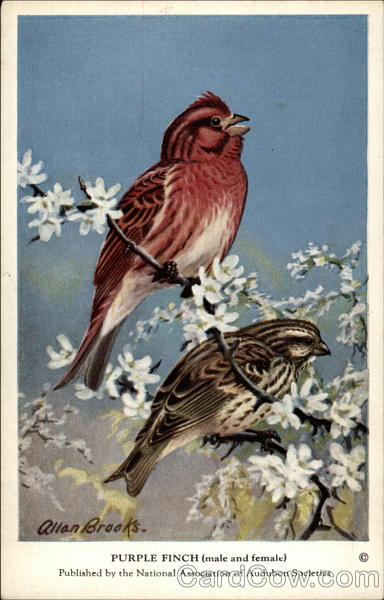Front:
**
Qllan Brooks.
PURPLE FINCH (male and female)
Published by the National Association of Audubon Societies
Back:
No. 29 Purple Finch
Length 644 inches
This species is known only as a migrant to the
people of the United States dwelling south of the
northern tier of states. The Purple Finch is just
a rose-colored Sparrow, the male being streaked
and marked with raspberry-red over a portion of
his body, while the plainly colored fanalo might
easily be mistaken for any one of a number of
Sparrows. In winter the Purple Finch scatters in
small flocks over much of the eastern United
States south of its breeding range. In the South
it prefers cedar thickets and evergreen forests. It
has a natural roving disposition, and wanders
widely, occurring with no degree of regularity in
a given locality. On accorijit of its habit of eating
tender buds, particularly those af fruit trees, or-
chardists now and then have lodged vigorous com-
plaints against this bird vo
Its song is a sudden chear, joyous burst of
melody, which ranks high as a vocal performance.
The nest is usually on the branch of an ever-
green and is composed of grasses and small weed
stalks lined with horsehair. Three or four green-
ish-blue eggs spotted with brown are laid.
Classification: Order Passeres. Family Fringillide.
Scientific name: Carpodacus purpureus.
Range: Eastern North America, breeding from Brit-
ish Columbia, Ontario and Newfoundland to North
Dakota and New England. Winters south of its breeding
range to the Gulf States.
No. 29 from set of 50 Winter Birds of the Northeastern United
States. Published by the National Association of Audubon So-
cieties, 1974 Broadway, New York City. Price per set, in a box,
$1.00 post paid.



